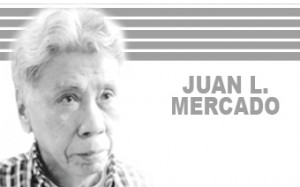 Leaf through the 2015 follow book “Philippine Native Trees 101â€. Early on, you’ll find that,once again, it measures up to the subtitle: “Up Close and Personal, that was published three years back.
Leaf through the 2015 follow book “Philippine Native Trees 101â€. Early on, you’ll find that,once again, it measures up to the subtitle: “Up Close and Personal, that was published three years back.
Lopez Group Foundation chairman emeritus Oscar M. Lopez wrote the perceptive foreword: In welcoming the followup edition, he underscores that the Philippines — which “harbors more diversity of life than any other country on earth on a per hectare basis …is losing that at a alarming rate…”
Lopez hailed Imelda P. Sarmiento, who edited the first book with it’s first 108 documented reports. Sarmiento oversaw the current edition on 123 native trees.
“It took more time to collect the next stories on 123 native trees,” Sarmiento of Hortica Filipina Foundation writes. “The discourse is too important to be left the exclusive domain ( of scientists ) and heaven forbid, loggers…The flora of the Philippines is probably the least known of any country in Southeast Asia”notes the old work by Dr E. D. Merril.
“We scientists, in developing countries, .need to come down from the ivory tower and disseminate results, not only in peer-review journals,” asserts Dr Jurgene Primavera, once named by Time Magazine as one of the world’s top 100 scientists, “We do science in a vacuum but against the grinding poverty and environment-unfriendly character of modern times…to make life more full for ( all )….â€
Hortica Filipina Foundation and Green Convergence published this book which depicts 108 of over 3,000 native species. They range from the critically-endangered “Starburst†or “Bagawak Morado†to the “ the Landscaping World’s Toastâ€: “lubi-lubi or niyog-niyogan.â€
Stunning photos illustrate the book. They include Ilocos Norte’s “loktob†to kamalan of Isabela. Many were culled from archives of the late Leonardo Co, foremost Filipino authority in ethnobotany.
Co was doing research in Kananga Leyte on 15 November 2010. The 16th Infantry Battalion troops claimed it engaged communist rebels then.Co was killed with his guides. An independent mission, led by physicist Dr. Giovanni Tapang, reports there was no firefight, Gunfire originated from the military The Department of Justice filed homicide raps against two officers and eight enlisted men. It was murder, Co’s family protested.
Typhoons Yoling to Juaning confirmed Leonardo Co’s advocacy for native trees. Only native trees like igot and pili survived., Hortica Filipina Foundations’ Imelda Sarmiento writes in the preface. “When asked for names of our native trees, most stop at narra.â€
Few know that 67 percent of native trees are found nowhere else. ’â€Where are they now?,†Sarmiento asks. “For years, I planted acres of alien species at La Mesa dam, Tarlac and around the metropolis.†Such programs wrecked biodiversity pools by foisting ill-suited alien tree species.
“Native Trees 101†will “hardly rectify some of environmental wrongs we’ve done,â€â€™ Sarmiento adds. “But it is a start…towards reintroducing our own trees to our own people.’.
“So, what’s wrong with our molave?â€, we asked 11 years back.. Vitex parviflora, is Philippine mahogany. It is legendary choice for altars, mansion posts, even handles for the Moro kris, that January 12, 2002 column noted.. Who grouses about “tindalo?” Tough wood from afzelia rhomobodia encases fragments of the original cross that Ferdinand Magellan planted on Cebu ‘s seashore in 1521.
Indigenous trees, however, are given short shrift within many reforestation programs. Too many re-foresters work by the yardstick that holds: “Imported is sikat ( tops)” Cash, time and effort are funneled into monoculture plantations, sown to nine “introduced exotics.” These include gemelina and teak from India; Malaysia ‘s labang or candlenut tree; mahogany from Central America .
“Monoculture of exotics is of low diversityâ€, Franz Seidenschwarz of Munich University told a University of San Carlos forum in 2002. They’re. so unlike the original and mixed forests of Cebu. Instead, a blinkered preference for imports denigrates native trees.
As a result, the genetic base of plantations are constricted. Worse, it opens windows of vulnerability to disease. “Valuable native species are thinning,†cautioned Seidenschwarz, who is married to a Filipina,
Non-botanists stitched “Philippine Native Trees 101 together for non botanistsâ€. It breaks from rigid academic formats. Contents follow nature’s contours instead. There’s a chapter on “A Mangrove Eco-Parkâ€, another on “Coastal and Beach Trees†to “Mainstreaming Native Trees in Urban Greening.
“Storytelling reveals meaning without committing the error of defining it,†political theorist Johanna “Hannah” Arendt wrote. Indeed “Once upon a time†remains the time-tested tool for teaching. Personal accounts are a unique mark of this book.
Examples:
On a Sierra Madre Range , botanist Ulysses Ferras was taken ill. The nearest hospital was a day’s trek away. Dumagat guides stripped bark from the kalingag tree and brewed a crude jungle tea. That enabled Ferras to complete the month long study mission
Five years later, an endoscopy revealed Ferras had hiatal hernia and is under medication. “I look back in wonder how that medicinal tree sustained me.
“It was love at first sight,†wrote Jo Consuelo Quimpo, conservationist. “Why a tree that rivals Japan ’s cherry blossoms is called ‘balai lamok’ ( or house of mosquitoes) baffles. Sacred garlic pear or salingbobog once dotted Mother Ignacia street in Quezon City.Mid-Apiril, it explodes in color flowers that last much longer than cherry blossoms. Yet, it has not been cultivated by local horticulturists for urban landscaping.â€
“In two years, I’ll be 100 years old,†writes Tefoista Zuniga of Virac Catanduanes.†There are 24 children in her four generation family. “In childhood, Catanduanes did not suffer from typhoons of today’s standard. In my mid-life, storms were annual guests. In my twilight years, there’ve been fewer storms.
“But some things don’t changeâ€. The anonang tree remained constant. For our fevers, pounded anonang leaves were applied. It’s juice became our paste. After Catanduanes fiercest storms, coconut trees are strewn all over. But native trees survive. (By Juan L. Mercado)
